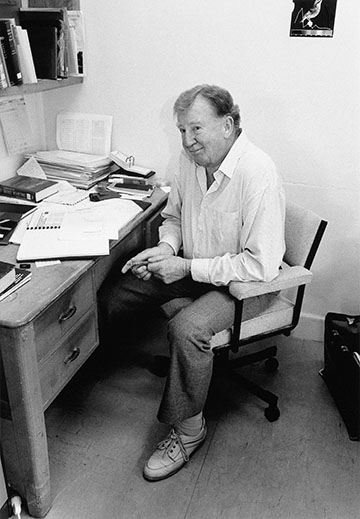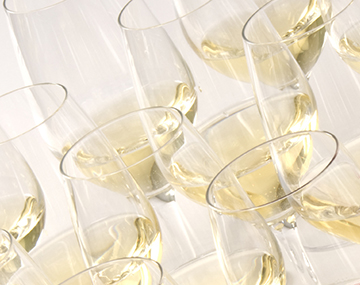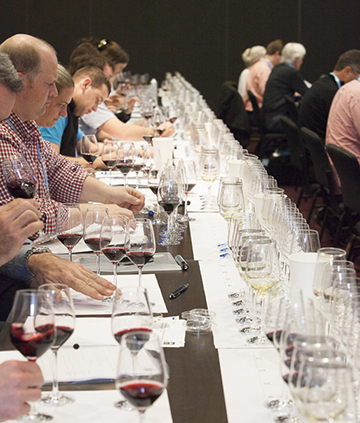Polysaccharides turning down the heat on white wine
Grazing sheep in vineyards to cut fuel use
Lees – minimising product losses and maximising quality
Restarting stuck or sluggish ferments
‘Dog book’ updates in progress
AWITC – time to book workshops, dinner tickets and accommodation
Revised version of the Food Standards Code
Order the latest AWRI staff publications online
Vale Dr Chris Somers |
|
 |
The AWRI community was saddened to hear of the death of Dr Chris Somers in April this year. Dr Somers was a highly respected researcher at the AWRI from 1962 to 1990 who leaves behind a significant scientific legacy. His highly influential work on wine colour and tannin is known worldwide and forms the foundation for current research in this area. His name lives on in the suite of spectral analyses used today to measure wine colour and phenolics, known as the ‘Somers’ method’. After his retirement, Dr Somers published a book entitled The Wine Spectrum: an approach towards objective definition of wine quality. |
Polysaccharides turning down the heat on white wine |
|
 |
Polysaccharides in white wine can inhibit both tartrate and protein precipitation, which means that higher levels of polysaccharides could lower the amount of energy and bentonite needed to achieve cold and heat stability. But how do increased levels of polysaccharides affect white wine mouth-feel? In a recently published study, white wines ‘fortified’ with realistic levels of white wine polysaccharides were seen as less ‘hot’ and in the case of higher pH wines, more viscous.
The study also found that the polysaccharides from grape pulp and those released by yeast during ferment were most likely responsible for the reduced hotness and increased fullness. Alcohol level and pH were found to be the largest influencers of mouth-feel and tastes in white wine – hotness, bitterness, fullness, acidity and astringency – making these key parameters for winemakers. The full paper detailing these results is accessible via the AWRI library: Gawel, R., Smith, P.A., Waters, E.J. 2016 Influence of polysaccharides on the taste and mouthfeel of white wine. Aust. J. Grape Wine Res. DOI: 10.1111/ajgw.12222 |
Grazing sheep in vineyards to cut fuel useFor many growers the biggest source of greenhouse gas (GHG) emissions from the vineyard is from fuel use. Australian vineyards are generally highly mechanised, and diesel is also used on some properties to pressurise irrigation systems. Using sheep to control midrow and undervine growth is one option to reduce the need for slashing and spraying and therefore reduce vineyard management costs and GHG emissions. Cumulus Vineyards in Orange, NSW recently trialled the use of sheep in the vineyard to assess the impacts on vineyard inputs, especially fuel use. The results of the trial led to Cumulus Vineyards grazing sheep across their entire 508 hectares which saved two tractor passes through the vineyard per year (one for slashing and one for spraying herbicide). The full results and more information about sheep grazing in vineyards can be found in a new case study developed as part of the Extension and Outreach project funded by the Australian Government Department of Agriculture and Water Resources. The AWRI Extension and Outreach team will be presenting a suite of new case studies including this one in a series of workshops around Australia in the coming months. Workshops will be publicised through regional associations, email notifications, the AWRI website, the Australian Grape and Wine Events Calendar and Twitter. For more information, please visit the AWRI website here or contact the AWRI helpdesk on helpdesk@awri.com.au or 08 8313 6600. |
|
Lees – minimising product losses and maximising qualityWine lees are typically processed by rotary drum vacuum filtration to recover the wine that is tied up in the lees. This can, however, result in product losses and quality downgrades. The AWRI is currently conducting research on wine lees and is convening an AWITC workshop on lees (W37) on 27 July in Adelaide. In this workshop you will hear from wineries that have trialled or adopted some of the newest alternative technologies for lees recovery. You will also discover the latest results from the AWRI’s research project. For more information, download this article published in the March issue of Aust. N.Z. Grapegrower & Winemaker, or contact Simon Nordestgaard (simon.nordestgaard@awri.com.au or 08 8313 6600). Registrations for the conference and workshop are now open at http://www.awitc.com.au/registration. |
|
Restarting stuck or sluggish fermentsThe AWRI sent out an eBulletin on stuck fermentations last month in response to several wineries encountering stuck or sluggish fermentations. Winemakers were advised to take action quickly to rack wines off ferment lees and to conduct a restart or rescue scale up-based procedure to finish their ferments. The AWRI restart procedure was prepared with assistance from the major yeast suppliers and has a successful track record. Extra information on managing difficult ferments can also be found in the following article:
For further assistance or information on stuck ferments, contact the AWRI helpdesk on helpdesk@awri.com.au or 08 8313 6600. |
|
‘Dog book’ updates in progressThe preparation of the 2016/17 edition of Agrochemicals registered for use in Australian viticulture (the ‘Dog Book’) has begun. Manufacturers of agrochemicals used in viticulture are being contacted to find out about any new or discontinued products. The recommended withholding periods for grapes destined for export wines are also being carefully reviewed, in conjunction with the Agrochemicals Reference Group. Once completed, the information in the updated ‘Dog Book’ will be made available via both print and online formats, with the printed ‘Dog Book’ usually distributed in July. For more information about the ‘Dog Book’, contact Marcel Essling on 08 8313 6600 or marcel.essling@awri.com.au. |
|
AWITC – time to book workshops, dinner tickets and accommodation |
|
 |
You may have already registered for the upcoming Australian Wine Industry Technical Conference (which incorporates WFA’s Outlook Conference) but have you booked everything you need to make the most of your time in Adelaide? Conference workshop places are filling fast and the Maurice O’Shea Award Dinner will be a highlight of the week.
There are 39 workshops to choose from, held over three timeslots on Sunday 24 July and Wednesday 27 July. Topics include social media tips, canopy management, lean production, organic viticulture, hot and cold stability, oak, wine flavour, lab testing, taxation, sparkling wine and clones for climate change. All the details are available on the AWITC workshop page. The Maurice O’Shea Award Dinner will take place on Monday 25 July, a short tram ride away from the conference at the Adelaide Entertainment Centre. This dinner is always a very special night for the Australian wine community and, like the WFA Outlook sessions, is being held in conjunction with the AWITC for the first time in 2016. Conference delegates are eligible for discounted tickets to the dinner – so make sure you book your tickets through the AWITC. If you have already registered for the conference, email info@awitc.com.au to add workshop and dinner tickets to your registration. If you haven’t registered yet, you can book everything in one place on the AWITC registration page. If you have any trouble, just call the AWITC office on 08 8313 6821. Special accommodation rates are also available for AWITC delegates – book via the AWITC accommodation page. |
Order the latest AWRI staff publications onlineAccessing the latest AWRI publications is easy. Visit the AWRI Publications web page to:
A full list of AWRI publications published since the last eNews is included below: 1806 Crauwels, S., Van Assche, A., de Jonge, R., Borneman, A.R., Verreth, C., Troels, P., De Samblanx, G., Marchal, K., Van de Peer, Y., Willems, K.A., Verstreppen, K.J., Curtin, C.D., Lievens, B. Comparative phenomics and targeted use of genomics reveals variation in carbon and nitrogen assimilation among different Brettanomyces bruxellensis strains. Appl. Microbiol. Biotechnol. 99: 9123-9134; 2015. 1807 Williamson, P.O., Lockshin, L., Francis, I.L., Loose, S.M. Influencing consumer choice: short and medium term effect of country of origin information on wine choice. Food Qual. Pref. 51: 89-99; 2016. 1808 Nordestgaard, S., Abbott, T. Winery lees: minimising volumes and recovering better quality juice and wine. Aust. N.Z. Grapegrower Winemaker (626): 62-64; 2016. 1809 Cowey, G. Ask the AWRI: Predicting alcohol levels. Aust. N.Z. Grapegrower Winemaker (626): p. 68; 2016. 1810 Johnson, D. Teasing [OUT] terroir. WBM (March/April): 56-57; 2016. 1811 Ristic, R., Fudge, A.L., Pinchbeck, K.A., de Bei, R., Fuentes, S., Hayasaka, Y., Tyerman, S.D., Wilkinson, K.L. Impact of grapevine exposure to smoke on vine physiology and the composition and sensory properties of wine. Theor. Exp. Plant Physiol. 28 (1) 67-83; 2016. 1812 Stockley, C.S. The relationships between alcohol, wine and cardiovascular diseases – A review. Nutr. Aging 3 (2-4): 55-88; 2015. 1813 Bekker, M.Z., Mierczynska-Vasilev, A., Smith, P.A., Wilkes, E.N. The effects of pH and copper on the formation of volatile sulfur compounds in Chardonnay and Shiraz wines post-bottling. Food Chem. 207: 148-156: 2016. 1814 Mierczynski, P., Vasilev, K., Mierczynska, A., Maniukiewicz, W., Szynkowska, M.I., Maniecki, T.P. Bimetallic Au-Cu, Au-Ni catalysts supported on MWCNTs for oxy-steam reforming of methanol. Appl. Catal. B Environ. 185: 281-294; 2016. 1815 Lee, D., Lloyd, N.D.R., Pretorius, I.S., Borneman, A.R. Heterologous production of raspberry ketone in the wine yeast Saccharomyces cerevisiae via pathway engineering and synthetic enzyme fusion. Microb. Cell Fact. 15 (49): 1-7; 2016. 1816 Taylor, A., Barlow, N., Day, M.P., Hill, S., Patriarca, M., White, M. Atomic spectrometry update: review of advances in the analysis of clinical and biological material, foods and beverages. J. Anal. At. Spectrom. 31 (3): 554-595; 2016. 1817 Curtin, C., Cordente, T. What’s old is new again: yeast mutant screens in the era of pooled segregant analysis by genome sequencing. Microbial Cell 3 (4): 1-2; 2016. 1818 Varela, C., Sengler, F., Solomon, M., Curtin, C. Volatile flavour profile of reduced alcohol wines fermented with the non-conventional yeast species Metschnikowia pulcherrima and Saccharomyces uvarum. Food Chem. 209: 57-64; 2016. 1819 Moran, M., Petrie, P., Sadras, V. Sensory attributes of Barossa Shiraz 2015 in response to warming and pruning date. Aust. N.Z. Grapegrower Winemaker (627): 50-51; 2016. 1820 Stockley, C. Ask the AWRI: Health and nutrition labelling. Aust. N.Z. Grapegrower Winemaker (627): p. 66; 2016. 1821 Waterhouse, A.L., Lamuela-Raventós, R.M., Quifer-Rada, P., Stockley, C.S. Wine. Shahidi, F., Alasalvar, C. (eds.) Handbook of functional beverages and human health. Boca Raton, FL: CRC Press Taylor & Francis Group LLC: 739-755; 2016. |
|
AcknowledgementThe AWRI acknowledges support from Australia’s grapegrowers and winemakers through their investment body, Wine Australia, with matching funds from the Australian Government. The AWRI is a member of the Wine Innovation Cluster in Adelaide, South Australia. |
|

